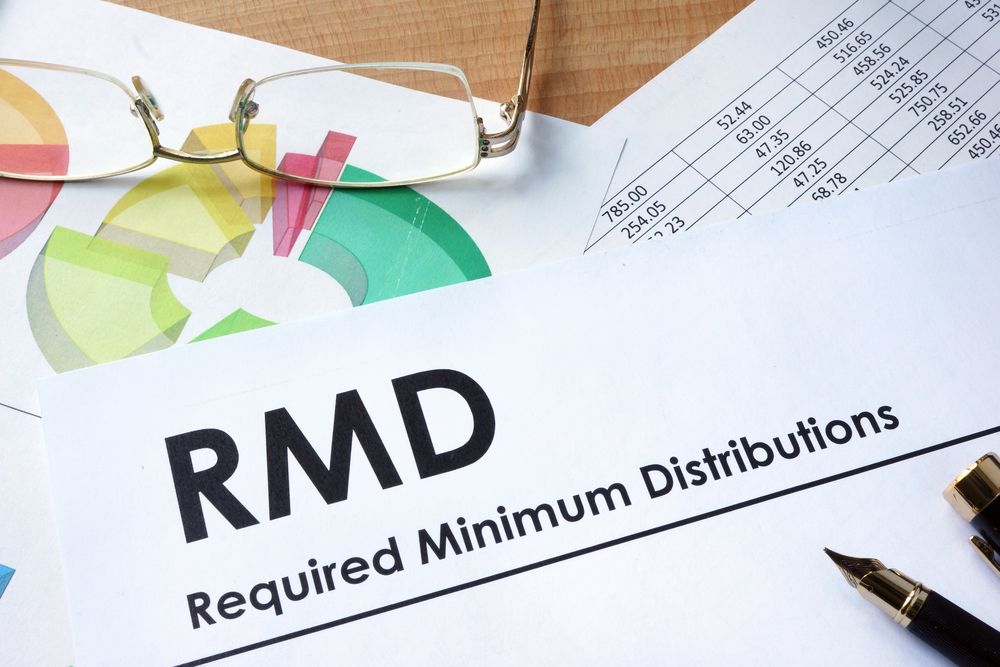Secure in your 401(K)?
As is customary with our family, we had a (mandatory) New Year’s Day dinner celebration. It’s a wonderful time when the six of us (are forced to) share highlights and lowlights of the prior year and share our hopes and dreams for the year ahead. It went something like this,
Billy: “Okay, welcome to the 2023 McCarthy Family New Year’s Dinner!
First, I’d like to thank you all for…” [Interrupted by son #4]
#4: “Hey dad, let me guess, you’re going to get in shape, eat better, and sleep more.
Please pass the meat.”
I took the liberty of removing the distraction of food from son #4’s personal space and allowed him to listen to the rest of the family’s plans for 2023 unincumbered, that is, until I was over-ridden. And while I might resemble his remarks, he left out at least one important component. The part where I learn from my mistakes.
Over committing on resolutions isn’t uncommon and underperforming on them likely isn’t either. Missteps with your finances, however, can run the gamut from inconsequential to nearly catastrophic. Anybody relate? Hopefully, you have more experience with the former. But life happens. We all make mistakes and sometimes they’re expensive. So what housekeeping tips would we offer for 2023 that may keep you from making costly decisions? And what’s new for 2023 and beyond that you should be aware of? Let’s start the year off with a little Retirement Account Housekeeping, shall we? (We’ll substitute Retirement Account with 401(k) for simplicity’s sake.)
401(k) Housekeeping Tip #1:
Max the Match. If you’re currently participating in a retirement plan that has an employer matching contribution component, whereby they’ll match a percentage of your contribution up to a certain percentage of your compensation, I’d encourage you to capitalize on this benefit and max the match. Here’s how it works: Maybe your employer matches 50% of your contribution up to 6% of your compensation. If you contribute 6% of your compensation, you’ll be maxing the match , as they say. By putting in 6% of your compensation into your 401(k), you’ll receive a 3% match from your employer (50% of 6% = 3%). There’s a technical term we use in the advisory world for that. It’s called: free money [from the Latin freebieus cashus]. And if you’re maxing the match, that means you’ll be getting all the free money that’s available to you. Check with your administrator today on what your plan may provide for.
The mistake to learn from: Jack didn’t max the match and missed out on free money.
401(k) Housekeeping Tip #2:
If your plan allows you to contribute a percentage or a fixed dollar amount, contribute a percentage. Why so? Okay work with me: Let’s say that throughout your career, you’ve made a good impression on the right folks and have found yourself making a good deal more money than when you started. And let’s say you chose to have a fixed dollar amount deposited each pay period. Anybody see the problem? (I’ll wait.) The amount you’re saving isn’t increasing along with your income is it? No. The fixed dollar amount is – fixed. You’re putting in the same dollar amount at with an income of $150,000 that you were putting in when you earned $50,000. Had you put in a percentage of your pay, your contributions would be increasing relative to your income. That means more money with more time in the market. And that’s not even considering an employer match. If you’re fortunate enough to have employer contributions being made on your behalf, maxing the match may allow for an even greater amount of savings. Use a percentage, not a fixed dollar amount.
The mistake to learn from: Jack used a fixed dollar amount and missed out on increased retirement savings and the potential for additional compounding returns.
401(k) Housekeeping Tip #3:
If you have an old 401(k), 403(b) 457(b) or other employer sponsored retirement account, you may be able to transfer that account into your existing plan. Ask your plan administrator about your specific situation. You may even consider rolling that old balance into an IRA to take advantage of different investment options and services. Sure, why not, right? What you don’t want to do, is leave it somewhere and forget about it. I’m willing to venture that some of you have old retirement accounts out there, somewhere, and you’re unaware of the balance and of how it’s invested. Am I right? And of course, you don’t want to just “cash it out” without very careful consideration. While you may feast on an immediate influx of cash, you may also enjoy a side of premature distribution and the accompanying 10% penalty if you’re under 59.5. And any pre-tax distribution made will be added to your taxable income for the year in which it was taken. Speak with your advisor or tax preparer about your particular situation if you’re considering a cash distribution.
The mistake to learn from: Jack didn’t do anything with his old account and eventually forgot he had one. Lots of potential for missed opportunity.
401(k) Housekeeping Tip #4:
Let’s talk about your beneficiary. Do you know who your beneficiary is for your 401(k)? If you paused for even half a second, you need to check. Make sure you know who you’ve listed as the primary beneficiary of your 401(k). Here’s why. The beneficiary designation on your 401(k) is the last will and testament for what one day, could be your single largest asset. And once you’re gone – as in dead – it’s too late to change it. And that goes for insurance policies, too. So check your insurance policy beneficiaries while you’re at it. Go ahead. I’ll wait. It’s that important. Maybe even the most important aspect of your 401(k).
The mistake to learn from: Jack never checked his beneficiary after his divorce. Jack died. Jack’s ex-wife soon bought a new car…and a new garage to put it in…that came with a new house.
401(k) Housekeeping Tip #5:
Be aware of changes that could affect your retirement. A new bill was signed into law at the end of last year that you should be familiar with. It’s the Secure Act 2.0. Yes, it does sound familiar, doesn’t it? That’s because the first SECURE (Setting Every Community Up for Retirement Enhancement) Act was signed into law in 2019. Hence, the need for its clever surname – 2.0.
While there are over 90 new retirement plan provisions, I’ll not cover them all. In fact, I’m just going to mention a few published online earlier this year by Investopedia, titled Secure Act 2.0 Act of 2022. Some will take effect in 2023, of course, while others not until 2024, 2025 and even 2033.
401(k) Auto Enroll:
Beginning in 2025, Section 101 of the act requires employers to automatically enroll eligible employees into 401(k) or 403(b) plans with a minimum participation amount of 3% but no more than 10%. The percentage will increase 1% per year up to a minimum participation amount of 10% and a maximum of 15%. That said, employees will be able to opt out of the plan if they wish, or select a different contribution percentage. This auto-enroll requirement only applies to new plans in 2025 – not existing 401(k) plans. There are some businesses that are exempt from this provision. (Small businesses with 10 or fewer employees, new business (less than 3 years old), church and government plans. (U.S. Senate, Committee on Finance. “SECURE 2.0 Act of 2022 Summary,” Page 1.)
RMD Age Change: Section 107 increases the RMD age from 72 to 73. This change takes effect on January 1, 2023. The RMD age will change again in 2033 to 75. (U.S. Senate, Committee on Finance. “SECURE 2.0 Act of 2022 Summary,” Page 2.)
Pre-Death RMD: Section 325 eliminates the pre-death RMD for the owner of a Roth-designated account in an employer 401(k) or other retirement plan. Under current law, required minimum distributions are not required to begin prior to the death of the owner of a Roth IRA, although pre-death distributions are required in the case of the owner of a Roth-designated account in an employer retirement plan. This provision takes effect for taxable years beginning after December 31, 2023. (U.S. Senate, Committee on Finance. “SECURE 2.0 Act of 2022 Summary,” Page 13.)
Catch-Up Contributions: Section 108 indexes the $1,000 catch-up contribution for savers age 50 and above to the IRS cost-of-living-adjustment (COLA). This provision is effective January of 2024 (U.S. Senate, Committee on Finance. “SECURE 2.0 Act of 2022 Summary,” Page 2.)
Catch-Up Contributions for those aged 60 to 63: Section 109 substantially increases catch-up limits for 401(k), 403(b), and 457 plan participants aged 60 to 63 to the greater of $10,000 or 150% of the “standard” catch-up amount for that year, beginning January, 2025. (U.S. Senate, Committee on Finance. “SECURE 2.0 Act of 2022 Summary,” Page 2.)
Catch-Up Contributions for those making more than $145,000 per year: Section 603 requires that beginning in January of 2024, catch-up contributions to your plan must be made with Roth (after-tax) dollars. (U.S. Senate, Committee on Finance. “SECURE 2.0 Act of 2022 Summary,” Page 18.)
Other: The Act also has provisions for natural disasters, domestic abuse, a Roth emergency savings account, and even a once per year, penalty free withdrawal up to $1,000 for personal or family emergency expenses.
For more information on how these provisions may apply to you, contact your 401(k)-plan administrator.
The mistake to learn from: Jack didn’t keep up with his benefits and missed out on opportunities to better his retirement.
One of the better quotes on mistakes comes from artist, Bob Ross, who said, “There are no mistakes, just happy accidents.” Sure, that may be true if you’re trying to paint a tree. And since Bob Ross isn’t your financial advisor, let’s go with this one, “Mistakes are much less painful when you learn from someone else having made them.”
Moral of the story when it comes to your retirement: Don’t be a Jack.
To learn more about CapSouth Wealth Management visit our website at capsouthwm.com/what-we-do/ or Connect With Us to learn more about our process.
By: Billy McCarthy, Wealth Manager
CapSouth Partners, Inc, dba CapSouth Wealth Management, is an independent registered Investment Advisory firm. Information provided by sources deemed to be reliable. CapSouth does not guarantee the accuracy or completeness of the information. CapSouth does not offer tax, accounting or legal advice. Consult your tax or legal advisors for all issues that may have tax or legal consequences. This information has been prepared solely for informational purposes, is general in nature and is not intended as specific advice. Any performance data quoted represents past performance; past performance is no guarantee of future results. This article contains external links to third party content (content hosted on sites unaffiliated with CapSouth). CapSouth makes no representations whatsoever regarding any third party content/sites that may be accessible directly or indirectly from this article. Linking to these third party sites in no way implies an endorsement or affiliation of any kind between CapSouth and any third party, including legal authorization to use any trademark, trade name, logo, or copyrighted materials belonging to either entity.



